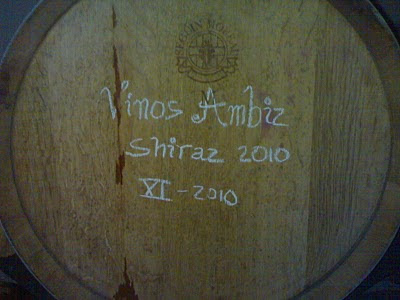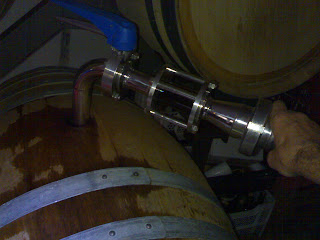No news is good news. Aromas are good (fruity and intense) and taste is good too. No off-tastes. We may rack it off its lees and release it for Christmas, along with the Normal Airén. (BTW, the we've decided not to clarify the Normal Airén this year, as the clarifier (egg-white) removes good flavours and aromas along with the particles in suspensión that are supposed not good. I think a little bit of extra cloudiness is a good price to pay for extra aromas and flavour. Agree, disagree?
From left to right:
Airén (Carbonic Maceration); Tempranillo; Airén (Normal)
Airén (Carbonic Maceration); Tempranillo; Airén (Normal)
2. Airén on its skins
Again, no news is good news. Aromas and tastes are good. I've been advised by a few people (including Gottfried Lemprecht, who makes this kind of wine) to leave this wine alone for a long time. I guess I'll do that, and keep tasting it regularly to see how it evolves.
However, I'll have to fix the tap because it leaks!
Leaky tap
3. Shiraz
This is only an experiment in the sense that it's the first time we've made a Shiraz wine. We've oaked 1 barrel (225 l or 300 bottles) and the rest is staying in the stainless steel tank.
Shiraz in Tank
Shiraz In Oak
4. Petit Verdot
This lot of P.V. seems to be normal more or less, but we suspect something is up!!! Even though it's finished fermenting (apparantly, as the density is 996!) the aroma is still like what you get at the beginning of fermentation, ie compost, gassy, not very fruity. The taste is rather sweet, which suggests ther's some residual sugar in there. I dunno! At least there's nothing seriously serious happening! I'll have to get an experienced taster in to check it out. Any theories, anyone?
Garnacha (left) and Petit Verdot (right)
5. Graciano Explosion
I've kept the Graciano news for the last, because it's the most interesting! A few days ago the oak cask of Graciano exploded and made a huge mess in the barrel room!
I suppose that it hadn't finished fementing and the relative heat (18ºC) in the barrel room activated the yeast.
I missed the direct action and Juan (who's letting us share his bodega this year) kindly cleaned up the spillage. Here's some pics of the collateral damage:
Close-up of the bung-hole and environs
The bung itself has disappeared! It must be somewhere in the barrel room, but we haven't been able to find it yet!
The ceiling directly above the Graciano cask
The state of the cask beside the Graciano cask
The leak at the front of the Graciano cask
















